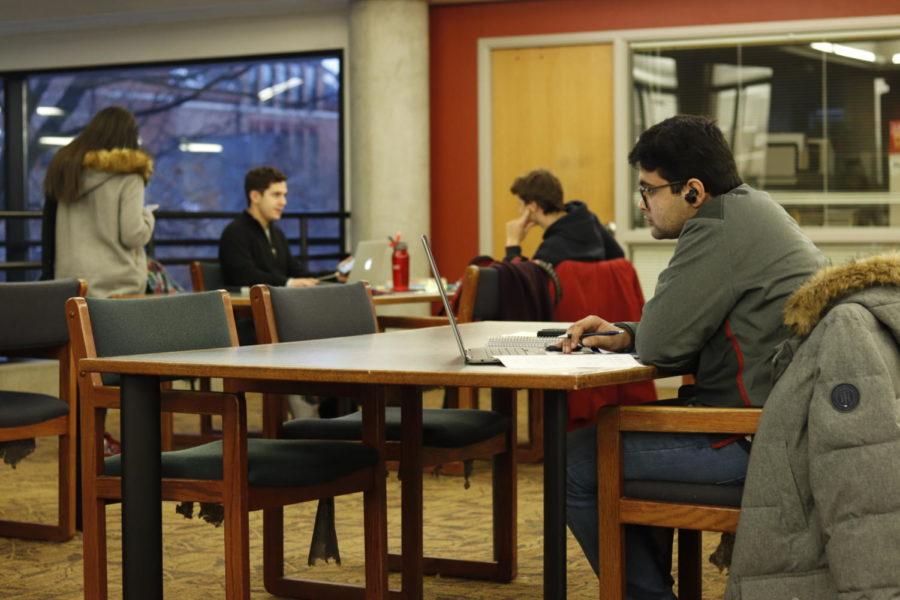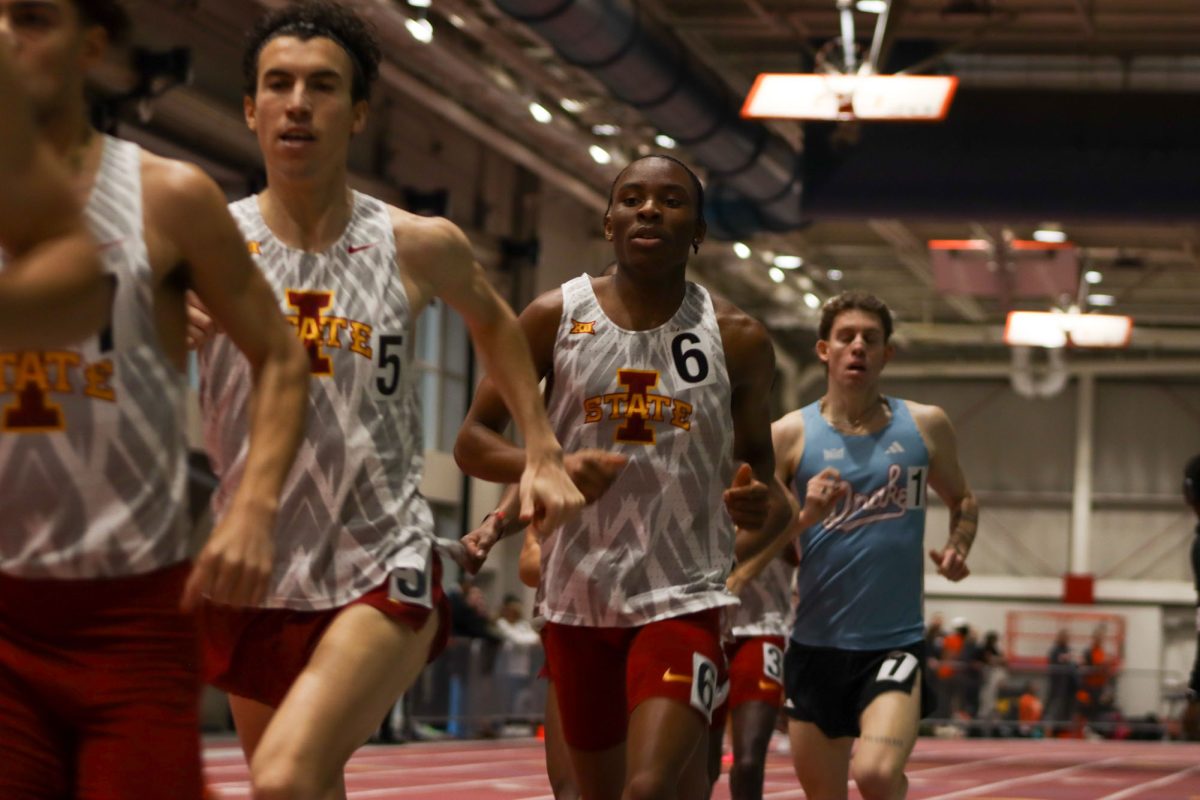Underrepresented on campus: The story of Asian international students and professors
Rutwik Korde (right) is a sophomore in mechanical engineering. He often finds himself studying in the library alone among other students who are in study groups. Korde said international students can sometimes feel left out due to cultural differences.
January 17, 2019
More than 60 percent of Asian students at Iowa State have experienced racial discrimination on campus, according to a presentation done by a research group from Iowa State University, which was presented at the 2018 Iowa State Conference on Race and Ethnicity. Many discrimination behaviors root from the model minority conception, according to the research.
After World War II, 61 percent of male Asian immigrants and 42 percent of female Asian immigrants had bachelor degrees or higher. Their children who came to the U.S. at young ages, and who were born in the U.S., also did well at school.
Starting from the 1960s, Asian Americans were portrayed as a “model minority,” meaning the success of Asian Americans should be attributed to Asian culture and values, which are diligent work, family stability and the pursuit of education.
Yingqi Huang, senior in psychology, said she has always been a good student but rarely gets compliments from her parents.
“When I was little, I often got more than 95 out of 100 grades, but my parent always asked me why I didn’t get 100 or how did I miss those points,” Huang said. “I guess that’s normal for Asian parents to do that because of the high expectation, but sometimes it hurts my feelings a bit.”
Huang also said sometimes she feels people don’t see her as a member of a minority group.
“In my group project, I once heard people say, ‘you are Chinese, shouldn’t you be good at math?’ or ‘You are really tall for being a Chinese girl,’” Huang said. “I know they meant to make a joke or offer me a compliment, but I think they won’t say those stereotypical things to an African American person.”
The research group defined model minority as “a demographic group (whether based on ethnicity, race or religion) whose members are perceived to achieve a higher degree of socioeconomic success than the population average.” This concept has gradually become a burden, and sometimes even a stereotype for Asian students.
Kevin Dang is a senior in industrial engineering and the president of the only Asian fraternity at Iowa State, Pi Alpha Phi. He said the most effective way for a group of people to fight for equality and eliminate stereotypes is unity; however, the Asian community is widespread. It’s complicated for people from every Asian country to gather together and voice their opinions because they identify themselves on uneven levels.
“Imagine there is an ‘Asian spectrum.’ You have people on one end who think that Asian culture and values are the most important element in their identities, and you have another group of people on the other end who don’t even see themselves as Asians,” Dang said. “It’s sometimes confusing, to the point people just avoid the topic once for all.”
Su Jung Kim is a former professor of Iowa State’s Greenlee School of Journalism and Communication. Kim is originally from South Korea. She said that most Asian immigrants or Asian international students came to the U.S. from a decent background, often middle or upper class.
“We situated a bit different in society, comparing to African American and Hispanic immigrants, and that might cause others to view us differently,” Kim said.
Another point Kim raised is that culturally, most people from Asian countries have the tendency to keep their thoughts to themselves. They were raised to lay low and mind their own business.
“We are able to recognize issues or problems, but we hardly speak up, and that’s how I was raised,” Kim said.
Kim said the Asian students’ population at Iowa State is about 3 percent, and that this could make it more difficult for them to express their thoughts, because they may feel nobody would join them.
Another Asian professor, Tao Wang, who is from China, also spoke his mind on this topic. He said traditional Chinese education emphasizes memorization over critical thinking and respecting teachers’ methods over challenging them.
“Students are supposed to graduate as useful tools, instead of human beings with their own thinking or minds,” Wang said.
Wang said years of rigid educational training had shaped students into the way they are. Although they have the opportunity to study in the United States, the land of freedom, they still rarely start a discussion, join a club or get out of their comfort zone to make new friends — and when facing challenges or injustices from authorities, they would typically back down.
For those more reserved Asian students, Michael Bugeja, professor and former director of the Greenlee School of Journalism and Communication, analyzes what the university can do to help them improve.
“I would like to see more of them in departments working at desks and as student ambassadors,” Bugeja said. “So international students can feel more represented.”
Bugeja takes Greenlee School as an example. He said the Greenlee School has a vigorous standard on diversity, whose mission statement, strategic plan and programming all have diversity and inclusion as a core value. In addition to that, the Greenlee School is one of the few units on campus that has a stand-alone diversity plan.
“I have done studies and have found that relatively few departments at Iowa State have diversity in their mission statements or a stand-alone diversity plan,” Bugeja said. “It’s true that you can have those documents and say ‘well, we have those documents. We don’t have to do anything else.’ That’s kind of a cynical view of putting something on the record.”
Bugeja also said that once department heads put a policy on paper, the faculty vote for that policy and the administrator is held accountable for facilitating that policy.
“Transparency is particularly important in diversity issues,” Bugeja said. “Students need to know what efforts have been made in fairness and inclusion. We can continue to recruit and retain a diverse body.”
Bugeja also mentioned that individual professors could also make a change in students with more reserved cultural backgrounds.
“It’s my obligation to get to know every reserved student and to look at them in an educational way,” Bugeja said. “If we all adopt it as teachers at Iowa State University, I think we will be living examples of diversity of inclusion. If, however, we tend only to call on people who tend to look the way we look, we send a message to other students.”
Bugeja said he would go up to more reserved students in his classes and ask them how they are doing. Before or after class, he usually sits next to them and has a conversation or asks for their suggestions on lectures.
“I’ve noticed they spring to life because teachers take notice of them,” Bugeja said.







